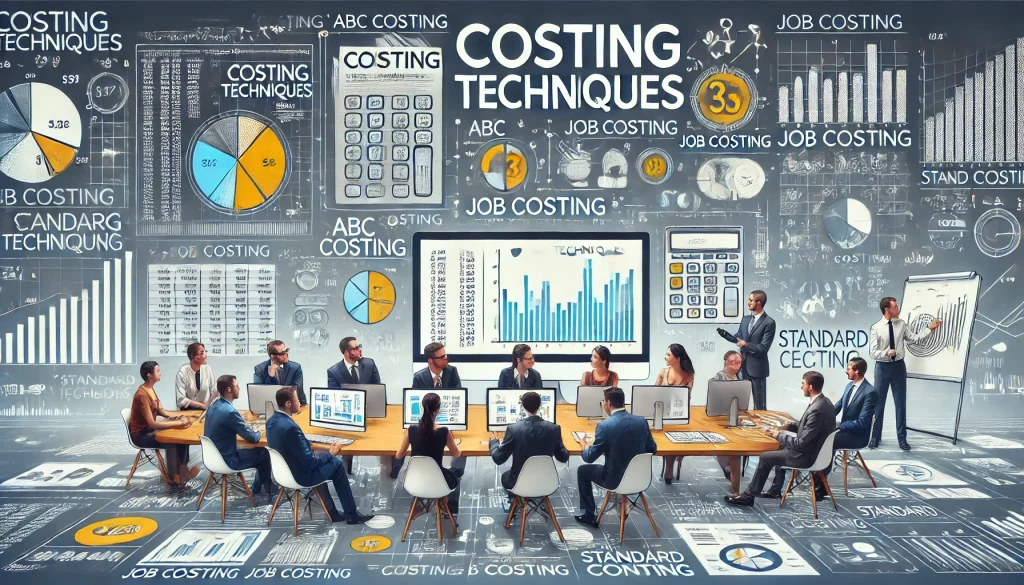Costing techniques play a significant role in the administration and management of business operations to optimize the available resources and minimize inefficiency. In management and accounting parlance, costing techniques are referred to as methods of calculating the cost of manufacturing a product or rendering a service. Such techniques are imperative for setting up prices, controlling overhead costs, and maximizing profitability. Knowing various costing techniques helps businesses understand the kind of decision to make in relation to production, budgeting, and investment.
Costing is far more than just a financial exercise; it is a management tool. There are many varied costing methods and techniques to accommodate the various differences between industries based on the nature of products, processes, or business objectives. This article goes deeper into these techniques, their applications, and their advantages for businesses.
What Are Costing Methods?
Costing methods are the approaches used by businesses in computing the costs of goods and services. These may vary with the production processes, type of business, and the general standard of the industry. The costing method is what helps the business to know how profitable a product is, keep expenditures under control, and make strategic pricing.
Types of Costing Methods
Job Costing
Job costing is used in industries where products are manufactured strictly according to customer orders. Every job is different, and the costs of that particular job are traceable and accumulated separately. Examples of this kind of industry are construction companies or manufacturers of custom furniture pieces.
Major Features:
- Costs are traced and allocated for each job separately.
- Overhead costs are absorbed based on actual hours worked or machine time used.
Contract Costing
costsLong-term projects are accumulated in contract costing. It is followed by the industries undertaking long durations big contracts. It is followed by construction firms. The costs are recorded for the entire period of the contract.
Key Features:
- Costs are spread over the contract period.
- Revenue recognition may be spread out according to the completion stages.
Cost-Plus Costing
A cost-plus approach is one where a markup is added to the cost of producing a product to ensure a margin for profitability. It is very commonly applied in an industry where pricing based on the costs incurred would involve a percentage added for profit.
Key Features:
- Transparent and easy to implement.
- Ensures all costs are covered while providing a guaranteed profit margin.
Batch Costing
Batch costing is applied in cases where products are produced in batches. Costings are given for each batch. Such industries include pharmaceuticals, clothing, and automotive components, which are prominent in using batch costing in the management of inventories.
Key Features:
- Economies of scale are often realized.
- Costs are averaged across the number of units in a batch.
Types of Costs
Understanding different types of costs is fundamental to applying costing techniques effectively. These costs can be classified into:
- Fixed Costs: These do not vary with quantity. Examples are rent, salaries, and insurance premiums.
- Variable Costs: This type of cost depends directly on the output produced and includes the cost of raw materials and the cost of direct labor.
- Semi-Variable Costs: Semi-variable costs contain both the fixed and variable elements. For example, utility bills have a fixed charge in addition to a variable rate for every unit consumed.
- Direct Costs: Those costs can be traced directly to some specific product such as raw materials or direct labor.
- Indirect Costs: Those costs cannot be traced to any product but are necessary for operations, for example, utilities or factory rent.
Techniques of Cost Accounting
Various techniques of cost accounting are put into play, depending on the specific business needs and pertinent financial situation. Gathering, analyzing, and reporting cost information, these techniques help businesses allocate their resources effectively. Out of the many techniques of cost accounting, the most commonly used are:
Standard Costing
The standard costing technique involves the first step of obtaining standard costs of materials, labor, and overheads that set a benchmark against which the actual performance of the organization can be evaluated. Then actual variances are calculated with standard costs to determine the areas of inefficiency.
Key Features:
- Facilitates budgeting and performance evaluation.
- Helps identify cost deviations and inefficiencies.
Marginal Costing
Marginal costing is related to the cost of producing one additional unit of a product. It is useful where specific choices need to be made, such as in pricing, finding the break-even point, and maximizing profit.
Key Features:
- Helps in understanding the cost behavior concerning changes in production levels.
- Useful in short-term decision-making.
Activity-Based Costing (ABC)
In this allocation of overheads, the activities that drive the costs are taken into account. In contrast to traditional costing methods, this method is more accurate in that it reflects how activities and their resources are interrelated.
Key Features:
- Provides detailed insights into indirect costs.
- Helps identify non-value-adding activities and improve operational efficiency.
Absorption Costing
Absorption costing assigns all manufacturing costs for both fixed and variable overheads on products, thereby typically being applied for external reporting.
Key Features:
- Costs are recovered fully in pricing.
- It is mainly applied to financial reporting.

Advantages of Cost Accounting
Cost accounting offers a range of benefits that extend beyond mere cost determination. These include:
- Enhanced Cost Control: Cost accounting helps the business to know where the costs go, identify the cost centers, and analyze the variances in standard costs.
- Comprise Informed Decision-Making: Cost accounting provides proper cost data that can be used for informed pricing decisions, investment, and also for deciding production strategies.
- Profitability Analysis: Cost accounting helps in analyzing profitability at different levels: an item-by-item, departmental, or company-wide level.
- Operational Efficiency: There are various methods, such as activity-based costing, that help the business discover areas of operational inefficiency and implement corrective actions toward increasing productivity.
Difference Between Cost Accounting and Financial Accounting
| Basis | Cost Accounting | Financial Accounting |
|---|---|---|
| Purpose | Assists management in internal decisions | Provides financial information to external stakeholders |
| Focus | Focuses on cost control and reduction | Focuses on profitability and financial position |
| Time Period | This can be done for specific projects. | Typically done for a financial period. |
| Reports | Detailed internal reports | Standardized financial statements |
| Users | Internal management | External stakeholders (investors, creditors) |
Conclusion
In conclusion, costing techniques are vital tools for modern business operations in order to smooth the process, keep costs under control, and improve profitability. By using the right costing method, whether it is job costing or batch costing, or marginal costing, a better understanding of the cost structure can be obtained, and therefore, informed decisions will be made towards sustainable success. Cost accounting with techniques like standard costing and activity-based costing also plays a great role in discovering inefficiencies and improving performance in general.
Costing Techniques FAQs
What is the difference between job costing and batch costing?
Job costing tracks costs individually for specific customer orders, whereas batch costing accumulates costs for a group of similar products produced in a batch.
Why is cost-plus costing used?
Cost-plus costing is used to ensure that all production costs are covered, plus a markup for profit, making it a reliable method for pricing.
How does marginal costing help in decision-making?
Marginal costing helps in understanding how costs change with production levels, aiding in decisions like pricing, production volume, and maximizing profits.
What is the primary difference between cost accounting and financial accounting?
Cost accounting focuses on internal cost control, while financial accounting provides information to external stakeholders like investors and creditors.
What is activity-based costing (ABC)?
ABC allocates overheads based on activities that drive costs, providing a more accurate picture of indirect costs.


